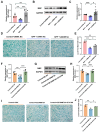Oligodendrocyte-Specific STAT5B Overexpression Ameliorates Myelin Impairment in Experimental Models of Parkinson's Disease
- PMID: 40801579
- PMCID: PMC12346846
- DOI: 10.3390/cells14151145
Oligodendrocyte-Specific STAT5B Overexpression Ameliorates Myelin Impairment in Experimental Models of Parkinson's Disease
Abstract
Background: Parkinson's disease (PD) involves progressive dopaminergic neuron degeneration and motor deficits. Oligodendrocyte dysfunction contributes to PD pathogenesis through impaired myelination. Methods: Single-nucleus RNA sequencing (snRNA-seq) of PD mice revealed compromised oligodendrocyte differentiation and STAT5B downregulation. Pseudotemporal trajectory analysis via Monocle2 demonstrated impaired oligodendrocyte maturation in PD oligodendrocytes, correlating with reduced myelin-related gene expression (Sox10, Plp1, Mbp, Mog, Mag, Mobp). DoRothEA-predicted regulon activity identified STAT5B as a key transcriptional regulator. Results: Oligodendrocyte-specific STAT5B activation improved myelin integrity, as validated by Luxol Fast Blue staining and transmission electron microscopy; attenuated dopaminergic neuron loss; and improved motor function. Mechanistically, STAT5B binds the MBP promoter to drive transcription, a finding confirmed by the luciferase assay, while the DNMT3A-mediated hypermethylation of the STAT5B promoter epigenetically silences its expression, as verified by MethylTarget sequencing and methylation-specific PCR. Conclusions: DNMT3A inhibited the expression of STAT5B by affecting its methylation, which reduced the transcription of MBP, caused oligodendrocyte myelin damage, and eventually led to dopamine neuron damage and motor dysfunction in an MPTP-induced mouse model. This DNMT3A-STAT5B-MBP axis underlies PD-associated myelin damage, connecting epigenetic dysregulation with oligodendrocyte dysfunction and subsequent PD pathogenesis.
Keywords: Parkinson’s disease; methylation; myelin sheath; oligodendrocyte; single-nuclear RNA sequencing; substantia nigra.
Conflict of interest statement
The authors declare no conflicts of interest.
Figures















Similar articles
-
Early B Cell Factor 3 (EBF3) attenuates Parkinson's disease through directly regulating contactin-associated protein-like 4 (CNTNAP4) transcription: An experimental study.Cell Signal. 2024 Jun;118:111139. doi: 10.1016/j.cellsig.2024.111139. Epub 2024 Mar 11. Cell Signal. 2024. PMID: 38479556
-
ALS-linked mutant TDP-43 in oligodendrocytes induces oligodendrocyte damage and exacerbates motor dysfunction in mice.Acta Neuropathol Commun. 2024 Nov 27;12(1):184. doi: 10.1186/s40478-024-01893-x. Acta Neuropathol Commun. 2024. PMID: 39605053 Free PMC article.
-
Exercise Ameliorates Dysregulated Mitochondrial Fission, Mitochondrial Respiration, and Neuronal Apoptosis in Parkinson's Disease Mice via the Irisin/AMPK/SIRT1 Pathway.Mol Neurobiol. 2025 Jul;62(7):8843-8856. doi: 10.1007/s12035-025-04801-z. Epub 2025 Mar 6. Mol Neurobiol. 2025. PMID: 40048058
-
Quaking Protein in Myelin Maintenance and Regeneration in the Central Nervous System.Mol Neurobiol. 2025 Jun 24. doi: 10.1007/s12035-025-05144-5. Online ahead of print. Mol Neurobiol. 2025. PMID: 40555892 Review.
-
Uncommon Non-MS Demyelinating Disorders of the Central Nervous System.Curr Neurol Neurosci Rep. 2025 Jul 1;25(1):45. doi: 10.1007/s11910-025-01432-8. Curr Neurol Neurosci Rep. 2025. PMID: 40591029 Review.
References
Grants and funding
LinkOut - more resources
Full Text Sources
Research Materials
Miscellaneous

